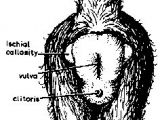The breasts of the human female are unique in the animal world.
Many people would look at a woman's breasts as having a maternal role rather than sexual, but a biological analysis proves this to be false.
Other species of primates ensure an abundant milk supply for their offspring without developing swelled well-defined hemispherical breasts.
It's just the solid, rounded woman breast what poses a problem to breast feeding, being a big problem for the mouth and the nose of the baby, who - in many cases - is suffocating while sucking. A long nipple over a flat chest, like in the case of the chimp female, is much more suited for feeding the offspring with maternal milk.
And, in fact, most of the woman's breats is not made of mammary glands (which produce milk) but of a mix of conjunctive tissue and fat tissue (that's why when a woman slims, breasts face the risk of getting smaller).
The development of conspicuous breasts with a characteristic shape seems to be a way of sexual signaling. This fact was encouraged during the human evolution by the nude skin, which emphasized them.
When men are attracted by a woman's breasts they do not think "Oh, she's gonna be a good mother!", they simply experience sexual arousal. And when a woman wears bras and other methods to emphasize her breasts, she does it to improve sexual appeal, not to show how good she is for breast feeding ?Nor do I believe that women who want to have breast implants aim at improving their baby's nutrition...
Besides their prominent form, breasts serve for focusing the attention on the nipples and make more evident the nipple's erection during sexual arousal. The pigmented skin zone around the nipples - that intensifies its color during the sexual arousal - acts in the same direction.
But why are human breasts a sexual stimulant?
The answer has to do with the changes in human sexuality during the evolution from monkey to human.
Basic sex in humans takes place face to face; in a monogamous species like ours, the frontal contact strengthens the ties between the two individuals.
Others link the face-to-face position also to the vertical bipedal position of the humans. But with the bipedal position a problem came up. Most female monkeys and apes possess buttock pads (ischial callosities) (image 2,3 in vervet monkey and bonobo), thick and brightly colored tissue around their genitalia. These organs serve for sexual signaling.
When a female is in estrus, the pads swell and redden, and this is the signal a male needs and that a male will understand.
Moreover, the female approaches the male exposing its rear zone, the male comes closer and they mate without any frontal contact.
But, in the bipedal position, the pads would be hidden, so the human lost them.
Initially, they may have been replaced by the fleshy human buttocks for sexual signaling, but in face-to-face sex, the rear part is not conspicuous. That's why some ethologists believe that the breasts are a "frontal self imitation" of the buttocks. In other words, breasts in humans imitate the buttocks and correspond to the ape and monkey's buttock pads.
Humans are not the only primates presenting "frontal self imitation". Gelada Baboons (photo 4), which live in the Ethiopian plateau, have the genitalia surrounded by a vivid red skin portion, edged by white papilae. This pattern is imitated in the monkey's chest area, where a naked red skin patch is surrounded by white papilae. In the center of this particular chest region, the nipples got so close to one another that they strongly resemble the genital lips.
Like the genital area, the color of this skin patch varies along the menstrual cycle, being intense during the ovulation.
What's very interesting and should be mentioned is that Geladas pass a lot of time in a vertical position, like humans do, period when the genitalia are inconspicuous.
Even the mandrill's vivid blue and red face is mimicking its genital area, the red nose imitating the red buttocks, and the blue cheeks imitating the blue testicles.
In humans, the female must be continuously sexually receptive, so the male won't search for other females while she is not in estrus. That's why buttocks and breasts do not suffer color changes along the menstrual cycle: human female is signaling all the time!
In other primates, females mate only during the estrus (with the exception of bonobos).
And here comes another question: why do men prefer big breasts?
Well, because - as any sexual signal - they depict better fitness (like, let's say the peacock's tail or a lion's mane). The development of breasts requires energy to be consumed. Bigger breasts signal strong fitness, because only a fit body can afford to invest so much in a trait that is basically non-essential for its survival.
Thus, this female's organism is able to invest more in producing offspring than the body of a woman with smaller breasts would be.
This is - of course - an evolutionary explanation, since during the stage of hunters-gatherers, early people did not have such an easy access to food like modern people do.
Continous natural selection produced the woman's well-developed breasts.
Some may come up with the observation that cows also have huge udders. A cow's udder is not the result of natural selection, but of man made selection in order to increase milk production. That's why an udder has a very different composition, compared to a breast and it is really made mostly of mammary glands. A cow with its huge udder would not survive in nature because the huge investment in developing it is ensured only by the food supply provided by men, and such animals would be too slow at escaping predators. In fact, the cows of aurouch, the ancestor of the domestic cattle, had small udders and so do the current wild relatives of the cow, like the African buffalo, the banteng, the gaur (wild cattle from Southern Asia) or the bisons (both European and American).
As an answer to the 4th comment: I'm quite astonished that a Biological Anthropologist (that must have read a lot to claim this title, not just have a phD research done), is not familiar with the work of Desmond Morris and anthropological studies of 2005-2006. This article is based on such researches and "The Naked Ape" by Desmond Morris.

 14 DAY TRIAL //
14 DAY TRIAL // 


